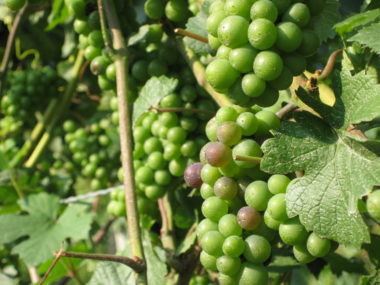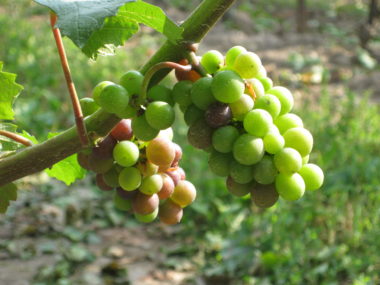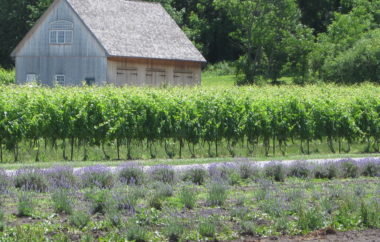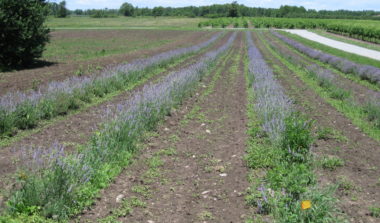Every Wine Has a Story
Every vintage and every wine has a story. Some are thrillers, some are tragedies, some are uplifting romantic dramas and some, like the story of “Howie’s Own” 2008 Vidal, are dark comedies.
Tonight I cracked a bottle of this ’08 Vidal (bottled elegantly in a recycled Creekside Cabernet bottle) and marveled at the irony of how this wine that I cared about the least, neglected the most, and don’t sell to the public, turned out to be so damn good.
It’s an understatement to say that I wanted no part of making this wine in the late fall of 2008. Those unfortunate enough to be around me at that time would no doubt be able to describe the kind of mood I was in. Frazzled and crabby only begins to describe my state of being. Having just completed our first full-scale “Five Rows” vintage, in facilities that rivaled only the most modest of U-Brew joints, I’d actually spent the majority of my time scouting vineyards for other wineries to make ends meet. I was officially burnt out.
With evey sip of Vidal the stroy gets clearer.
My father, and I give him credit for mustering up the courage to do this, meekly suggested that we make a small tank of Vidal from the little bit of leftover fruit that falls onto the ground after mechanical harvesting, just for the fun of it. The fun of it? “You’ve got to be kidding me!” I thought or perhaps yelled aloud along with some interesting adverbs. I’d been slugging away for three months straight and making Vidal for fun was not high on my To Do list. I didn’t have the tank space, the yeast or the patience for this venture and made my feelings perfectly clear to a bewildered Howie.
“No problem.” he calmly stated, “I’ll make it myself.” Now this was funny. He didn’t have the foggiest notion about the practice of whole bunch pressing, the use of pectic enzymes, the protective benefits of potassium metabisulphate or how to properly monitor a fermentation. “Good luck with that!” I rudely exclaimed.
I arrived early the next morning to see him diligently stooping to pick up the fallen bunches of Vidal. I went on to tend to my other wines and after a while he pulled up to the crush pad with his wagon load of roadkill. Then, in a fateful moment of weakness, I decided to can the attitude and help my old man press some grapes. I suggested we press them “whole bunch” in an effort to be gentler on fruit. I’d done this before with Chardonnay in Nova Scotia and really felt that the end product was more complex. It also meant skipping the destemmer-crusher, which I didn’t feel like cleaning anyway.
We loaded the press quickly, I was probably still giving him the bum’s rush, and soon the sweet free-run juice began to flow. Normally, pressing is done slowly with gradual increases of pressure and a periodic break-up of the press cake. Sadly, this was not our protocol. I cranked the pressure input valve, quickly achieving one bar of pressure when, mysteriously, the free-run juice stopped flowing. Judging by the high-pitched squeal emanating from behind the wooden slats, I guessed we had an air pocket somewhere within our small basket press. Stupidly, instead of dismantling the press and breaking up the cake, I increased the pressure and leaned in for a closer look. All of a sudden, in one almighty instant, a tsunami of angry Vidal riding two bars of pressure streamed violently between a crack in the press screen, directly into my eyes and clear onto the roof of our barn!
Now if I say that I hit the ground and rolled around like I thought I was blind for life…it wouldn’t be a lie. I tend to be a bit of a drama queen at times, but I swear that this situation warranted my blasphemous screams. When I think back now, I truly believe that I’m lucky I wasn’t seriously injured. A seed or stem hitting an eye at that velocity could have done some serious damage, but the juice just stung. When I regained my vision enough to see blurry images, I quickly felt around and opened the pressure release valve to stop the geyser.
There are still a few Vidal skins adorning our barn roof to this day. When my dad and I recovered from the shock of the situation, we had a good and much needed laugh. I think we agreed not to tell my mother how bad it really was, but she will know now. Sharing that experience was priceless. I will never forget the look on his face when my vision finally returned. It was a weird amalgam of shock and stifled laughter that he’d be hard pressed to ever duplicate. Winemaking has since seemed less complicated and my attitude at vintage time has lightened tremendously. Taking time to enjoy the experience is my new motto.
In the end, we were able to scrape together some yeast and cold-fermented the Vidal in a small stainless steel tank. Last summer we bottled (more or less siphoned) 23 cases of Vidal, unfiltered, into sterilized, recycled bottles. We’ve been enjoying it ever since. The aromatics and presence of this wine are captivating. Our supplies are getting low, however, so maybe we’ll make some again this year…just for fun.
Good Reviews
When the back aches from successive days of thinning Pinot Gris that is trellised annoyingly too low (remind me to raise that damn bottom wire next year) its especially nice to retire to the winery for a pleasant afternoon tasting with someone who has recently “discovered” our wines. This has happened quite a bit lately, which signals to me that our wines are finding their way to the right people despite our lack of promotion.
My mother has shouldered the load for the majority for these pop-in tastings which she quite enjoys. Despite her claims of nervousness, I think she has really found her niche. She is passionate about our vineyards and loves to talk wine, especially Pinot!
We both feel very lucky when we receive firsthand positive feedback from our guests. It’s by far the most rewarding part of what we do. I’m still humbled and tremendously grateful every time people decide to purchase our wines.
Good reviews from a wine writer are nice too. Read what Michael Pinkus of Ontario Wine Review recently wrote about our 2007 reds here.
Slowly they turn…
That faint thud you just heard was my jaw hitting the terroir when I returned home from a quick vacation to find colour, yes colour, in my Pinot Gris and Pinot Noir. It seems eerily too early. The race is on, it’s veraison.

Veraison is the physiological stage of grape development where the hard, green berries finally soften and start to accumulate sugars and gradually turn colour. That first flash of colour is always a “noose tightener” of sorts, in that so many jobs need to be squeezed in before the imminent harvest. In early years such as this one, we are already fighting to keep the clusters exposed and canopy trimmed, but now it is even more important. Recent studies out of Cornell University have shown that longer fruit exposure to sun can decrease methoxypyrazine levels (green, vegetal characters) in late ripening varieties like Cabernet Sauvignon and Cabernet Franc.

Coloured berries also attract hungry birds, so our protective netting needs to be put up as soon as the hedging, leaf removal and cluster thinning is complete. I honestly can’t decide if I’m excited or horrified at the prospect of working every day for the next three months. I reassure myself that we go through the same song and dance every year, but that doesn’t seem to quell my uneasiness. Amid the vineyard duties, we have to squeeze in a bottling run and get all tanks and crush equipment ready for the first fruit of the season.
Just as my anxiety peaks, the faint light at the end of the tunnel begins to emerge. “Push on lad!”, I tell myself. Pluck a few more leaves, thin a few more bunches, finish one more row. Visions of brilliant autumn colours and cozy fall clothes begin to warm my thoughts. The thrill and challenge of ripening Shiraz emboldens me. I can taste that luscious free run juice now!
Bring on veraison!
Sold Out
Due to an unanticipated boon in sales, I regret to inform that our 2005 Cabernet Sauvignon and 2008 Sauvignon Blanc are now sold out. Maybe all this hot weather is making people really thirsty.
To build a library of past vintages I’ve decided to hold back a few cases of each red wine that we produce. I intend to personally monitor the aging process of these wines to determine when they are drinking best. A relatively new wine region like ours has little knowledge of the long term aging potential of our reds. Wines are generally drunk young, and perhaps ahead of their best days. I hope to shed some light on this age-old conundrum.
A couple of weeks ago I decided to crack a bottle of our 2004 Cab Sauv at a dinner with family and friends. Upon nosing and tasting, I cooly expressed my pleasant surprise to the group (privately I was downright giddy) at the immense progress this wine had made since the last time I tried it 6 months ago. I would encourage those who still have a bottle of the ’04 in their cellar to give it a try sometime soon with a nice red meat dish. It’s also a goal of mine to keep our regular customers abreast of the development of these wines through invite-only vertical tastings. I’ve also held back some unfiltered versions of each vintage, which would be fun to try at these events as well. Stay tuned to the blog for details.
For a limited time it’s still possible to purchase the 2008 Sauv Blanc and 2005 Cab Sauv at our great stable of Licensees, which now includes Spencer’s at the Waterfront in Burlington, About Thyme Bistro in Vineland, and Langdon Hall in Cambridge.
Wilma’s Lavender
Wilma’s Five Rows of Lavender



Vineyard Update
It dawned on me today, as I hurriedly thinned Pinot Gris in the midst of an earthquake, that I hadn’t given a thorough vineyard update in a while. So here goes…
Mother nature is two weeks ahead. I’m three weeks behind. This good news / bad news situation is the familiar refrain I’ve heard in talking to many grape growers throughout the peninsula. We’ve seen a boon of growth in all vines over the last couple of weeks, leaving us scrambling to keep up with the expedited hand labour chores. Adequate rainfall, heat, and blistering sun are making my vines very happy, but leaving me a little worried. Disease pressure has been low to this point (kiss of death) but the current humid conditions will challenge even the best of viticultural practices.
The accelerated growth creates the need to shoot-thin and shoot-position all vines before we are able to start hedging. As always, vine vigour was particularly problematic in our Shiraz blocks, so I targeted them first. After two weeks of what felt like hacking through a rainforest with a dull machete, I was happy to kiss the Shiraz good-bye and move on to the more manageable Cabernet Sauvignon. We are well through bloom in all varieties, and very close to berry touch stage in the Pinot Gris. Air flow through the canopy is critical at this stage, as is fruit exposure for optimum fungicide penetration.
I’m happy to report that the young Pinot Noir vines we planted last season are doing very well, with less than 5% vine failure. In the spirit of Father’s Day, I give my dad all the credit for these thriving vines. It was he who ploughed the field ad nauseam to his own exacting specifications, he who sat vigil through many winter and spring evenings waiting to fire up the windmill, and he who artfully maneuvered the grape-hoe around each baby vine with the deft touch of a surgeon. Judging by a couple of the catastrophic first year fields I’ve witnessed while out consulting this year (upwards of 60% vine death), I really believe that the use of the windmill combined with proper site selection and field preparation helped save our bacon.
PS: I send a special thank-you and congratulations to Insite Design for designing an Ontario Wine Awards silver medal winning wine label that still makes me proud every time I slap one on a bottle!
2007 Cabernet Sauvignon
I want to personally thank all the people who made the trek to our first ever Customer Appreciation Weekend! It was great to catch up with those we hadn’t seen in a while and also meet some new friends along the way. We decided to give people a sneak preview of upcoming Five Rows releases including the 2007 Pinot Noir and 2007 Cabernet Sauvignon. After some gentle prodding, it was decided to also tap into some promising tank samples of our 2008 Shiraz and 2009 Riesling. I sincerely appreciate all the constructive feedback.
We are now filling orders for the 2007 Pinot Noir, so you’re welcome to pick up your pre-ordered case if you haven’t already done so. The 2007 Cab Sauv also generated a lot of interest over the weekend, so I now feel confident releasing this wine for sale.
2007 Five Rows Cabernet Sauvignon
Vinification Notes:
My third crack at crafting a single-varietal Cabernet Sauvignon sourced from our own vineyard was by far the least stressful to date. We hand picked just under a tonne (900kg) of ripe, clean fruit on October 25th, 2007. This harvest date really snuck up on us, as we hadn’t really anticipated the Cab being that ripe, that early. For growers of multiple grape varietals, harvest time is a crazy sprint from the first Pinot’s of mid-September to the last of the Cab Sauv in November. To pick ripe Cab in October is a luxury we are rarely afforded.
Normally a row of Cabernet Sauvignon in our vineyard would yield about 500kg of fruit, but the 4 rows we sourced for this wine were thinned down to one bunch per shoot resulting in a yield of 225kg/row. The fruit came in like sweet little black marbles, at a shade under 24 degrees brix. After processing and a brief cold soak, the fruit was warmed back up for fermentation. I decided to use Zymaflore F15 yeast for this wine to maximize glycerolic production. I figured this would be a big wine from the get-go, so any added elements to help round out the mouthfeel would eventually pay dividends. Fermentation was carried out at a nice moderate pace over 7 days, with peak temperature of 26.8 degrees Celsius. Malolactic fermentation was completed in barrel to aid in oak integration.
After 24 months in one old and one new French oak barrel, this wine was blended to a stainless steel tank for final settling. 50 cases were eventually bottled on February 18, 2010. My only regret at the end of this process is that I didn’t have the foresight to make more Cabernet Sauvignon form this superb vintage.
Aromas: blueberry pie, black cherry, mint, oak spice, red licorice
Flavours: raspberry, blueberry, dark chocolate, powerful length
Cellaring: Drinking well now, but should age gracefully for 20+ years
Price: $50 / bottle
2007 Pinot Noir Vinification Notes
2007 Five Rows Pinot Noir
Vinification Notes:
The hot summer of 2007 brought ideal picking conditions to the St. David’s Bench. Roughly three tonnes of Pinot Noir were hand-picked on September 23 at just under 22 degrees brix, having TA of 6.55 and pH 3.31. Prior to picking, seed and skin tannins were both showing excellent maturity, and flavours were reminiscent of ripe seasons past (1998, 2001).
It was decided to source equal amounts of fruit from the three Lowrey Pinot blocks of differing ages (20 years, 15 years and 10 years). Each block was processed into open-top fermentors, with 15% of the fruit being left as whole-bunch. Bins were then sealed and underwent a lengthy cold soak to promote extraction.
Ferments were generally quick and warm, with peak temperatures in the low 30s. The wines were pressed into five French oak barrels (2 new, 3 old). Malolactic fermentation was carried out over the next few weeks in barrel.
After about a year of aging, it was apparent that the 2007 reds packed a real punch in both flavour and tannin. To mellow the mouthfeel, it was decided after bench-top trials to fine the wines with small volumes of Pinot Gris lees from the 2008 vintage. Following a few days settling, the wines were racked off all lees.
24 months and countless blending trials later, the final cut was married together in a stainless steel tank for final settling and stabilization. 99 cases of this wine were bottled on February 18, 2010.
Aromas: cherry, strawberry, raspberry, earth, and faint tobacco leaf
Palate: flavours of luscious black cherry, great balance, and ample tannin for optimal aging potential
Price: $50 / bottle. Your order can be directed to wines@fiverows.com.
Assiniboine College
What a pleasure it was to have a keen group of culinary/hospitality students from Assiniboine Community College (Manitoba) stop by our barn this morning. Prior to their arrival, I worried that it may be tough to keep our guests entertained for the full two and a half hours they were scheduled for, but once I met them I knew it wouldn’t be a problem!
They were all ears as my mother and I took turns explaining the history of our farm and some of the viticultural practices we employ. The rest of the time was filled with very well thought out questions and subsequent discussion. We concluded the morning with a tasting of our wines, of which I received some great feedback. It is a perk of my job to be able to meet such engaging and talented young people getting set to embark on their careers. I wish them all the best of luck in their future endeavours, and thank them for bringing a sampling of Five Rows back home to Brandon, Manitoba.
A special thanks also goes to Barbara Leslie from Niagara College for hooking us up with our new friends.
Ontario Wine Awards
Five Rows is very proud and excited to be among the finalists for “Best Label Design” at the upcoming Ontario Wine Awards. You can participate in the online judging at the Ontario Wine Awards website. May 21st is the deadline to cast your vote for a chance to win four tickets to the gala event on June 17th. It will be a great night to indulge in the finest wines our province has to offer. The event also marks the Toronto debut of our 2007 Pinot Noir.
I look forward to seeing you there!
